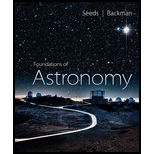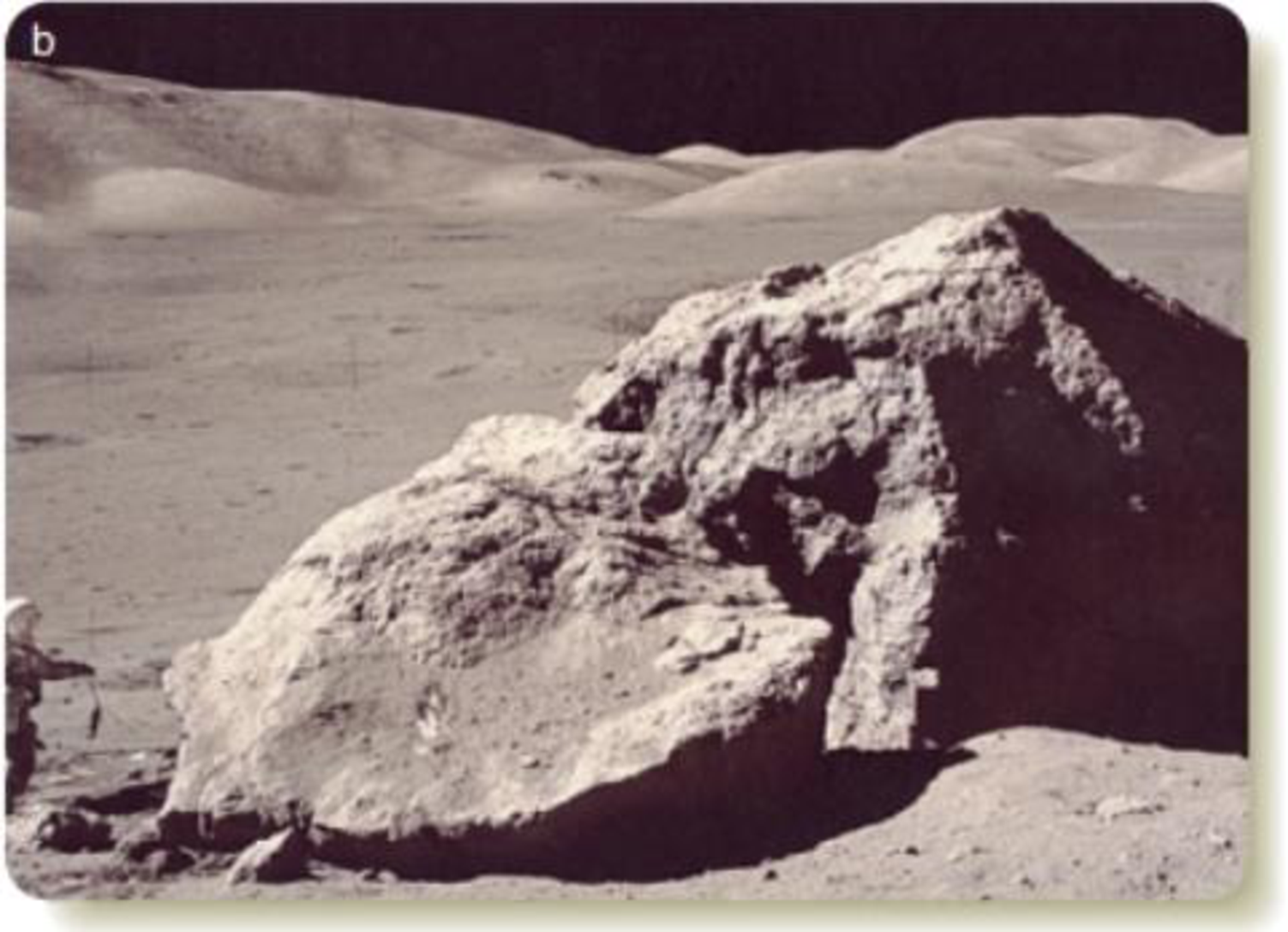
Foundations of Astronomy (MindTap Course List)
14th Edition
ISBN: 9781337399920
Author: Michael A. Seeds, Dana Backman
Publisher: Cengage Learning
expand_more
expand_more
format_list_bulleted
Textbook Question
Chapter 20, Problem 3LTL
Examine the shape of the horizon at the Apollo 17 landing site (Figure 20-4b). What processes shape mountains on Earth that have not affected mountains on the Moon?

Expert Solution & Answer
Want to see the full answer?
Check out a sample textbook solution
Students have asked these similar questions
Example
Two charges, one with +10 μC of charge, and
another with - 7.0 μC of charge are placed in
line with each other and held at a fixed distance
of 0.45 m. Where can you put a 3rd charge of +5
μC, so that the net force on the 3rd charge is
zero?
*
Coulomb's Law Example
Three charges are positioned as seen below. Charge
1 is +2.0 μC and charge 2 is +8.0μC, and charge 3 is -
6.0MC.
What is the magnitude and the direction of the force
on charge 2 due to charges 1 and 3?
93
kq92
F
==
2
r13 = 0.090m
91
r12 = 0.12m
92
Coulomb's Constant: k = 8.99x10+9 Nm²/C²
✓
Make sure to draw a Free Body Diagram as well
Chapter 20 Solutions
Foundations of Astronomy (MindTap Course List)
Ch. 20 - How does the force of gravity cause tidal coupling...Ch. 20 - As viewed from Earth, how many times does the Moon...Ch. 20 - If the Moon is tidally coupled to Earth, is Earth...Ch. 20 - How can you determine the relative ages of the...Ch. 20 - From looking at images of the Moons near side, how...Ch. 20 - Why did the first Apollo missions land on the...Ch. 20 - Why do planetary scientists hypothesize that the...Ch. 20 - Prob. 8RQCh. 20 - Prob. 9RQCh. 20 - Prob. 10RQ
Ch. 20 - What is the most significant kind of erosion that...Ch. 20 - Provide evidence to support a hypothesis about...Ch. 20 - What evidence can you cite that the Moon had...Ch. 20 - What evidence would you expect to find on the Moon...Ch. 20 - How does the large-impact hypothesis explain the...Ch. 20 - Look at the Celestial Profiles for Earth, the...Ch. 20 - Look at the Celestial Profiles for the Moon and...Ch. 20 - Prob. 18RQCh. 20 - Look at the Celestial Profiles for Earth, the...Ch. 20 - Look at the Celestial Profiles for the Moon and...Ch. 20 - Why are features like the Moons maria not observed...Ch. 20 - What are the relative ages of the intercrater...Ch. 20 - What evidence can you give that Mercury has a...Ch. 20 - Why is it not surprising that there is no evidence...Ch. 20 - What evidence can you give that Mercury had...Ch. 20 - How are the histories of the Moon and Mercury...Ch. 20 - What property of the Moon and Mercury has resulted...Ch. 20 - Prob. 28RQCh. 20 - Look at the right top and bottom images in Figure...Ch. 20 - Calculate the escape velocity of the Moon from its...Ch. 20 - Prob. 3PCh. 20 - Why do small planets cool faster than large...Ch. 20 - The smallest detail visible through Earth-based...Ch. 20 - Prob. 6PCh. 20 - The trenches where Earths seafloor slips downward...Ch. 20 - An Apollo command module orbited the Moon about...Ch. 20 - Prob. 9PCh. 20 - What is the angular diameter of Mercury when it is...Ch. 20 - If you transmit radio signals to Mercury when...Ch. 20 - What is the wavelength of the most intense...Ch. 20 - Suppose you send a probe to land on Mercury, and...Ch. 20 - The smallest detail visible through Earth-based...Ch. 20 - Prob. 1SOPCh. 20 - Prob. 2SOPCh. 20 - Look at the image of the astronaut on the Moon at...Ch. 20 - In the photo shown here, astronaut Alan Bean works...Ch. 20 - Examine the shape of the horizon at the Apollo 17...
Knowledge Booster
Learn more about
Need a deep-dive on the concept behind this application? Look no further. Learn more about this topic, physics and related others by exploring similar questions and additional content below.Similar questions
- RT = 4.7E-30 18V IT = 2.3E-3A+ 12 38Ω ли 56Ω ли r5 27Ω ли r3 28Ω r4 > 75Ω r6 600 0.343V 75.8A Now figure out how much current in going through the r4 resistor. |4 = unit And then use that current to find the voltage drop across the r resistor. V4 = unitarrow_forward7 Find the volume inside the cone z² = x²+y², above the (x, y) plane, and between the spheres x²+y²+z² = 1 and x² + y²+z² = 4. Hint: use spherical polar coordinates.arrow_forwardганм Two long, straight wires are oriented perpendicular to the page, as shown in the figure(Figure 1). The current in one wire is I₁ = 3.0 A, pointing into the page, and the current in the other wire is 12 4.0 A, pointing out of the page. = Find the magnitude and direction of the net magnetic field at point P. Express your answer using two significant figures. VO ΜΕ ΑΣΦ ? Figure P 5.0 cm 5.0 cm ₁ = 3.0 A 12 = 4.0 A B: μΤ You have already submitted this answer. Enter a new answer. No credit lost. Try again. Submit Previous Answers Request Answer 1 of 1 Part B X Express your answer using two significant figures. ΜΕ ΑΣΦ 0 = 0 ? below the dashed line to the right P You have already submitted this answer. Enter a new answer. No credit lost. Try again.arrow_forward
arrow_back_ios
SEE MORE QUESTIONS
arrow_forward_ios
Recommended textbooks for you

 Foundations of Astronomy (MindTap Course List)PhysicsISBN:9781337399920Author:Michael A. Seeds, Dana BackmanPublisher:Cengage Learning
Foundations of Astronomy (MindTap Course List)PhysicsISBN:9781337399920Author:Michael A. Seeds, Dana BackmanPublisher:Cengage Learning AstronomyPhysicsISBN:9781938168284Author:Andrew Fraknoi; David Morrison; Sidney C. WolffPublisher:OpenStax
AstronomyPhysicsISBN:9781938168284Author:Andrew Fraknoi; David Morrison; Sidney C. WolffPublisher:OpenStax
 Horizons: Exploring the Universe (MindTap Course ...PhysicsISBN:9781305960961Author:Michael A. Seeds, Dana BackmanPublisher:Cengage Learning
Horizons: Exploring the Universe (MindTap Course ...PhysicsISBN:9781305960961Author:Michael A. Seeds, Dana BackmanPublisher:Cengage Learning An Introduction to Physical SciencePhysicsISBN:9781305079137Author:James Shipman, Jerry D. Wilson, Charles A. Higgins, Omar TorresPublisher:Cengage Learning
An Introduction to Physical SciencePhysicsISBN:9781305079137Author:James Shipman, Jerry D. Wilson, Charles A. Higgins, Omar TorresPublisher:Cengage Learning


Foundations of Astronomy (MindTap Course List)
Physics
ISBN:9781337399920
Author:Michael A. Seeds, Dana Backman
Publisher:Cengage Learning

Astronomy
Physics
ISBN:9781938168284
Author:Andrew Fraknoi; David Morrison; Sidney C. Wolff
Publisher:OpenStax


Horizons: Exploring the Universe (MindTap Course ...
Physics
ISBN:9781305960961
Author:Michael A. Seeds, Dana Backman
Publisher:Cengage Learning

An Introduction to Physical Science
Physics
ISBN:9781305079137
Author:James Shipman, Jerry D. Wilson, Charles A. Higgins, Omar Torres
Publisher:Cengage Learning
Kepler's Three Laws Explained; Author: PhysicsHigh;https://www.youtube.com/watch?v=kyR6EO_RMKE;License: Standard YouTube License, CC-BY